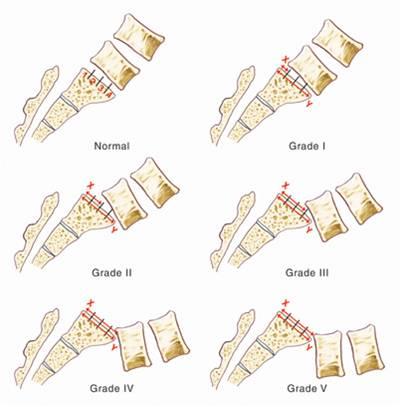What Is Herniated Disc?
Herniation describes a disruption in the integrity of the intervertebral disc that is also known as a “slipped,” “ruptured,” or “torn” disc.
This process occurs when the more jelly-like inner core (nucleus pulposus) squeezes out through the tougher outer layer (annulus fibrosus). This tear in the annulus fibrosus causes pain in the back or neck at the point of herniation. If the protruding disc presses on a spinal nerve, the pain may spread to the area of the body (for example, down the arm or leg) that is served by that nerve. This is called referred pain.
Most disc ruptures occur to young or middle-aged individuals. Although it can happen anywhere along the spine, the two most common locations for a herniated disc in the neck are at the discs between C5-6 and C6-7, and in the lower back are at the discs between L4-5 and L5-S1.

Symptoms
Patients typically complain of dull or sharp pain, which may be accompanied by muscle spasm or cramping. In some cases, there may be a previous history of episodes of localized neck pain that goes down the arm served by the affected nerve (see Cervical Radiculopathy), or low back pain that continues down the leg along the affected nerve distribution (see Sciatica). This pain is usually deep, which gets worse as it moves down the affected arm or leg. The onset of pain may occur out of the blue or it may be announced by a tearing or snapping sensation in the spine that is thought to be the result of a sudden tear in the annulus fibrosus.
In addition to pain, patients may experience burning, tingling, or numbness that radiates down into the arm, hand, and fingers (for a herniated disc in the neck), or goes down from the buttock into the leg and foot (for a herniated disc in the low back). In some cases, there may be noticeable weakness in the affected muscle. Although rare, herniated discs can sometimes cause loss of bowel or bladder control. If this happens, prompt medical attention is necessary.
Diagnosis
Usually, a careful history and physical exam can point to the affected level in the spine. Patients will often point to the neck or back, and trace where the pain travels down their arm or leg. Testing for decreased sensation and/or weakness provides further clue as to which nerve may be involved. Certain provocative maneuvers that elicit symptoms can be helpful. In addition, Dr. Cho will obtain and review various radiographic images (x-rays, MRI, etc.) with you to objectively assess where the symptoms are coming from. A special test called nerve conduction study is sometimes useful if another source of nerve compression (for example, carpal tunnel syndrome) is suspected.
Non-surgical Treatment
For the majority of patients, disc herniations can be successfully treated non-surgically. The pain typically resolves on its own within three months or so, and there are a number of treatments that can help relieve and manage the pain. These include physical therapy, various modalities, and medications such as muscle relaxants, non-steroidal anti-inflammatory drugs, Tylenol, or a short course of steroids. Nerve root blocks and epidural steroid injections may be used if there is significant leg or arm pain.
Surgical Treatment
Surgery may be recommended only when non-operative treatments have failed to resolve the pain and the patient still has severe symptoms. Profound weakness or numbness along the arm or leg may be an indication for early surgical intervention, along with sudden loss of bowel or bladder control.
If the disc herniation is found in the low back, Dr. Cho utilizes a high-power electronic microscope to perform microdiscectomy, whereby the affected nerve is freed by removing the herniated disc fragment. This is a minimally invasive procedure, and patients often leave the hospital on the same day.
For herniated discs in the neck, the spine can be approached from either the front (anterior) or the back (posterior). Anterior cervical discectomy and fusion is a highly effective procedure with excellent success rate. Motion-preserving procedures such as minimally invasive posterior laminoforaminotomy or artificial disc replacement may be offered as an alternative. Dr. Cho uses the high-power electronic microscope for all his cervical spine surgery.
